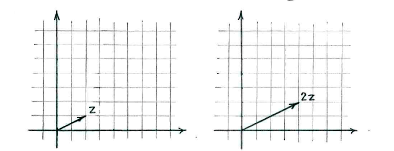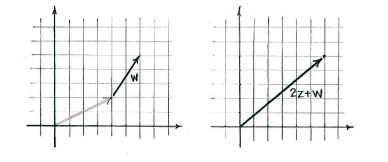Lösung 3.2:1c
Aus Online Mathematik Brückenkurs 2
(Unterschied zwischen Versionen)
K |
|||
| (Der Versionsvergleich bezieht 3 dazwischen liegende Versionen mit ein.) | |||
| Zeile 1: | Zeile 1: | ||
| - | + | Durch Rechnung erhalten wir | |
| - | {{ | + | {{Abgesetzte Formel||<math>2z+w = 2(2+i)+(2+3i) = 2\cdot 2 + 2 + (2+3)i = 6+5i</math>}} |
| - | + | Diesen Punkt können wir in der komplexen Zahlenebene einzeichnen. | |
| - | + | Wenn wir <math>z</math> und <math>w</math> als Vektoren sehen, ist <math>2z</math> doppelt so lang, aber hat dieselbe Richtung wie <math>z</math>. | |
[[Image:3_2_1_c1.gif|center]] | [[Image:3_2_1_c1.gif|center]] | ||
| - | + | Wir addieren <math>w</math> zu diesen Vektor und erhalten <math>2z+w</math>. | |
[[Image:3_2_1_c2.gif|center]] | [[Image:3_2_1_c2.gif|center]] | ||
Aktuelle Version
Durch Rechnung erhalten wir
| \displaystyle 2z+w = 2(2+i)+(2+3i) = 2\cdot 2 + 2 + (2+3)i = 6+5i |
Diesen Punkt können wir in der komplexen Zahlenebene einzeichnen.
Wenn wir \displaystyle z und \displaystyle w als Vektoren sehen, ist \displaystyle 2z doppelt so lang, aber hat dieselbe Richtung wie \displaystyle z.
Wir addieren \displaystyle w zu diesen Vektor und erhalten \displaystyle 2z+w.


